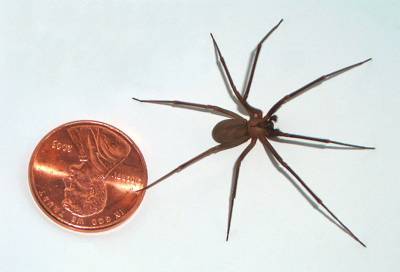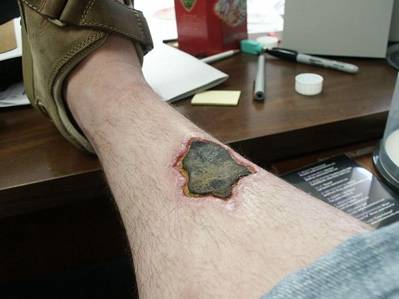Brown Recluse
Loxosceles reclusa
|
| Follow @Macroevo |

| |
|
Recluse Spider (Loxosceles reclusa)
| |

| |
| Two-month-old recluse spider bite Credit: Jeffrey Rowland |
True to its name, the brown recluse (Loxosceles reclusa) is a shy spider looking for a cozy home. Drawn to clutter, closets and other storage environments, these spiders actually want to stay away from humans. But, if you don't watch out, you may find yourself sharing your home with a dangerous guest, what University of Missouri entomologist Richard Houseman calls "one of the big three." The other two highly venomous spiders in the U.S. are the black widow and the hobo spider.
Brown recluses occur from Texas to western Georgia in the southern U.S., and range as far north as Iowa (see distribution map >>), but they are far less common toward the limits of their range. For example, only about 100 have ever been collected in the entire state of Georgia.
They are not aggressive, and because they are so reclusive, most bites happen by accident, says Houseman, an associate professor of entomology in the MU College of Agriculture, Food and Natural Resources. But their bites are frightful.
If you know you have brown recluses in your house, Houseman recommends checking clothing, shoes and bedding each time they're used.
"Often, bites occur when a person puts on a jacket or clothing that has a brown recluse spider inside," Houseman says. "If the spider feels trapped against a person's skin, it will bite in self-defense."
If bitten, there are some important actions to take immediately:
- Wash the site of the spider bite.
- Apply a cold compress.
- Apply a general antibiotic to the site to minimize the risk of secondary infection.
- See a doctor as soon as possible and try to capture the spider and take it with you so the bite can be confirmed as that of a brown recluse.
"The spiders inject what's called a hemotoxin," says Houseman. "The hemotoxin produces a blister that turns black and sloughs off within 24 hours leaving an ulcerous open wound that takes six to eight weeks to heal, leaving a permanent scar. In very rare cases, the bite may lead to fever, rash, vomiting, coma, and death within two or three days."
This spider seeks its winter home in attics, basements, or areas where things are placed and left for long periods of time. The spiders are drawn to boxes of papers or files, which have a lot of cracks and crevices to use for hiding. Minimizing clutter in and around the home and sealing boxes are important ways to reduce the chance of a large recluse population in a home. Bug sprays will not rid a house of these spiders. Like many spiders, they have long hairs on the bottom of their feet that enable them to walk across treated surfaces without getting a lethal dose. However, professional pest control companies have products that can be effective when applied to the spider's hiding places, according to Houseman.
"The best idea is to use sticky traps because the spiders will move onto the sticky traps and be caught," Houseman advises. "The traps can be thrown away and replaced easily. Over time, there will be fewer spiders caught, which indicates the population has been greatly reduced."
More about brown recluse spiders >>
Most shared on Macroevolution.net:
Human Origins: Are we hybrids?
On the Origins of New Forms of Life
Mammalian Hybrids
Cat-rabbit Hybrids: Fact or fiction?
Famous Biologists
Dog-cow Hybrids
Georges Cuvier: A Biography
Prothero: A Rebuttal
Branches of Biology
Dog-fox Hybrids